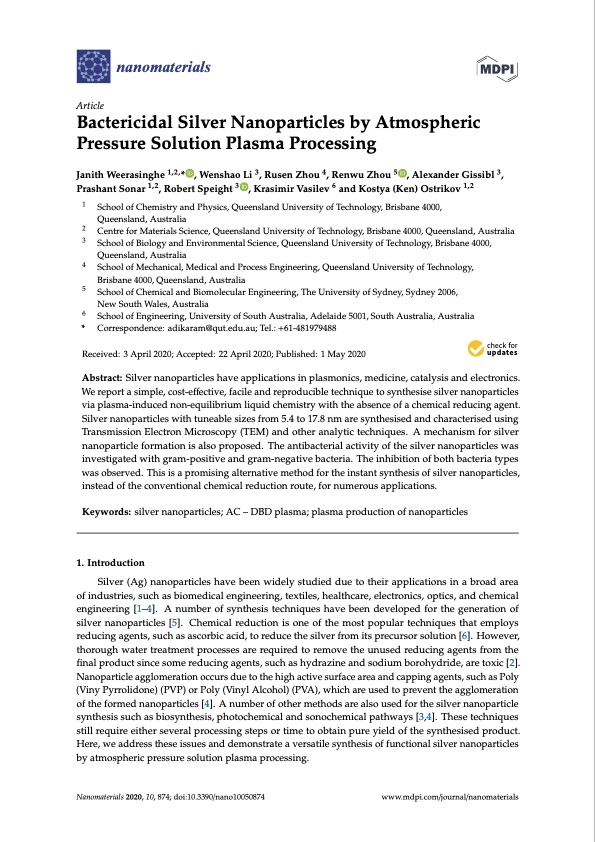
PDF Publication Title:
Text from PDF Page: 001
nanomaterials Article Bactericidal Silver Nanoparticles by Atmospheric Pressure Solution Plasma Processing Janith Weerasinghe 1,2,* , Wenshao Li 3, Rusen Zhou 4, Renwu Zhou 5 , Alexander Gissibl 3, Prashant Sonar 1,2, Robert Speight 3 , Krasimir Vasilev 6 and Kostya (Ken) Ostrikov 1,2 1 2 3 4 5 Received: 3 April 2020; Accepted: 22 April 2020; Published: 1 May 2020 School of Chemistry and Physics, Queensland University of Technology, Brisbane 4000, Queensland, Australia Centre for Materials Science, Queensland University of Technology, Brisbane 4000, Queensland, Australia School of Biology and Environmental Science, Queensland University of Technology, Brisbane 4000, Queensland, Australia School of Mechanical, Medical and Process Engineering, Queensland University of Technology, Brisbane 4000, Queensland, Australia School of Chemical and Biomolecular Engineering, The University of Sydney, Sydney 2006, New South Wales, Australia School of Engineering, University of South Australia, Adelaide 5001, South Australia, Australia 6 * Correspondence: adikaram@qut.edu.au; Tel.: +61-481979488 Abstract: Silver nanoparticles have applications in plasmonics, medicine, catalysis and electronics. We report a simple, cost-effective, facile and reproducible technique to synthesise silver nanoparticles via plasma-induced non-equilibrium liquid chemistry with the absence of a chemical reducing agent. Silver nanoparticles with tuneable sizes from 5.4 to 17.8 nm are synthesised and characterised using Transmission Electron Microscopy (TEM) and other analytic techniques. A mechanism for silver nanoparticle formation is also proposed. The antibacterial activity of the silver nanoparticles was investigated with gram-positive and gram-negative bacteria. The inhibition of both bacteria types was observed. This is a promising alternative method for the instant synthesis of silver nanoparticles, instead of the conventional chemical reduction route, for numerous applications. Keywords: silver nanoparticles; AC – DBD plasma; plasma production of nanoparticles 1. Introduction Silver (Ag) nanoparticles have been widely studied due to their applications in a broad area of industries, such as biomedical engineering, textiles, healthcare, electronics, optics, and chemical engineering [1–4]. A number of synthesis techniques have been developed for the generation of silver nanoparticles [5]. Chemical reduction is one of the most popular techniques that employs reducing agents, such as ascorbic acid, to reduce the silver from its precursor solution [6]. However, thorough water treatment processes are required to remove the unused reducing agents from the final product since some reducing agents, such as hydrazine and sodium borohydride, are toxic [2]. Nanoparticle agglomeration occurs due to the high active surface area and capping agents, such as Poly (Viny Pyrrolidone) (PVP) or Poly (Vinyl Alcohol) (PVA), which are used to prevent the agglomeration of the formed nanoparticles [4]. A number of other methods are also used for the silver nanoparticle synthesis such as biosynthesis, photochemical and sonochemical pathways [3,4]. These techniques still require either several processing steps or time to obtain pure yield of the synthesised product. Here, we address these issues and demonstrate a versatile synthesis of functional silver nanoparticles by atmospheric pressure solution plasma processing. Nanomaterials 2020, 10, 874; doi:10.3390/nano10050874 www.mdpi.com/journal/nanomaterialsPDF Image | Bactericidal Silver Nanoparticles by Plasma Processing

PDF Search Title:
Bactericidal Silver Nanoparticles by Plasma ProcessingOriginal File Name Searched:
nanomaterials-10-00874.pdfDIY PDF Search: Google It | Yahoo | Bing
Turbine and System Plans CAD CAM: Special for this month, any plans are $10,000 for complete Cad/Cam blueprints. License is for one build. Try before you buy a production license. More Info
Waste Heat Power Technology: Organic Rankine Cycle uses waste heat to make electricity, shaft horsepower and cooling. More Info
All Turbine and System Products: Infinity Turbine ORD systems, turbine generator sets, build plans and more to use your waste heat from 30C to 100C. More Info
CO2 Phase Change Demonstrator: CO2 goes supercritical at 30 C. This is a experimental platform which you can use to demonstrate phase change with low heat. Includes integration area for small CO2 turbine, static generator, and more. This can also be used for a GTL Gas to Liquids experimental platform. More Info
Introducing the Infinity Turbine Products Infinity Turbine develops and builds systems for making power from waste heat. It also is working on innovative strategies for storing, making, and deploying energy. More Info
Need Strategy? Use our Consulting and analyst services Infinity Turbine LLC is pleased to announce its consulting and analyst services. We have worked in the renewable energy industry as a researcher, developing sales and markets, along with may inventions and innovations. More Info
Made in USA with Global Energy Millennial Web Engine These pages were made with the Global Energy Web PDF Engine using Filemaker (Claris) software.
Infinity Turbine Developing Spinning Disc Reactor SDR or Spinning Disc Reactors reduce processing time for liquid production of Silver Nanoparticles.
| CONTACT TEL: 608-238-6001 Email: greg@infinityturbine.com | RSS | AMP |